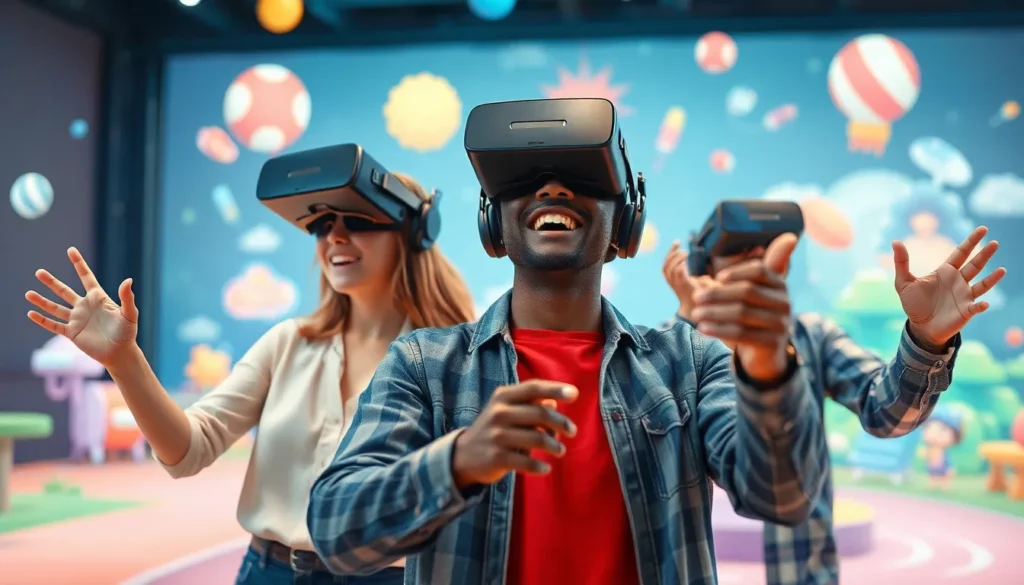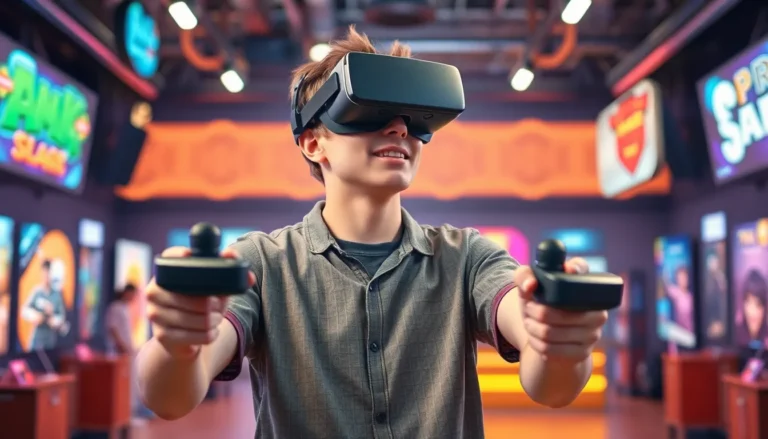Table of Contents
ToggleVirtual reality is no longer just a playground for tech enthusiasts; it’s a digital universe waiting to be explored. Cross-platform VR is the magic key that unlocks this universe, allowing users from different devices to interact seamlessly. Imagine a world where your friend on a headset can join your adventure, even if they’re using a completely different system. It’s like a virtual party where everyone’s invited, and nobody has to worry about awkward small talk.
As the VR landscape evolves, cross-platform compatibility is becoming essential. It’s not just about the latest graphics or immersive experiences; it’s about bringing people together in ways that were previously unimaginable. Whether you’re a gamer, an educator, or just curious, cross-platform VR opens doors to collaboration and creativity. So strap on your headset and get ready to dive into a world where everyone can play together, regardless of their tech preferences.
Overview of Cross-Platform VR
Cross-platform VR stands as a crucial advancement, allowing users across various devices to unite in virtual spaces. This innovation enhances social interactions by bridging gaps between traditional and mobile VR systems. Gamers feel more engaged when they can play together, regardless of their hardware. Educators benefit from shared learning experiences, fostering collaboration in lessons.
Numerous platforms support cross-platform functionality. Popular VR systems include Oculus, HTC Vive, and PlayStation VR; each contributes to a unified experience, enabling users to engage without device limitations. Additionally, developers prioritize cross-compatibility when designing new applications, ensuring a broader audience can participate.
Seamless integration becomes vital for immersive storytelling as it invites diverse participation. Creative content thrives in cross-platform environments, providing various experiences tailored to different user preferences. With a shared virtual experience, communities grow stronger and more interconnected.
Leading titles like “Rec Room” and “VRChat” exemplify successful implementations of cross-platform VR. These platforms allow users to create and socialize freely, ensuring user retention through engaging content. Interactive experiences capture attention when they welcome players from multiple ecosystems.
Industry leaders recognize the relevance of cross-platform capabilities. They frequently invest in technologies that enhance compatibility, aiming to provide richer experiences. As VR continues to evolve, cross-platform functionality is essential for broadening reach and improving user engagement, aligning with the growing demand for inclusivity in digital environments.
Benefits of Cross-Platform VR

Cross-platform VR offers significant advantages that enrich user experiences and broaden access to immersive environments. These features enhance interactions by connecting users across various devices.
Enhanced User Experience
Cross-platform VR fosters a richer user experience. Gamers enjoy greater engagement when their friends can join regardless of device differences. Unique content creation thrives in platforms like “Rec Room” and “VRChat,” where users from different systems come together. Developers prioritize universal compatibility in applications, which promotes diverse participation. Seamlessly integrated storytelling becomes possible, offering immersive narratives that resonate across devices. This inclusivity helps build larger communities, as users feel more connected while exploring virtual worlds.
Increased Accessibility
Increased accessibility remains a key benefit of cross-platform VR. Users without access to high-end hardware can still participate in experiences alongside others. Each person’s choice of device becomes less of a barrier to entry. Platforms such as Oculus, HTC Vive, and PlayStation VR facilitate connections, allowing more individuals to join in on the fun. Collaborative learning opportunities emerge, as educators utilize shared environments for diverse teaching methods. Overall, cross-platform functionality enhances participation and empowers users to engage with VR technology freely.
Technical Challenges in Cross-Platform VR
Cross-platform VR encounters several technical challenges that affect user experience and application performance. Issues related to connectivity and platform standardization frequently arise.
Connectivity Issues
Connectivity issues often disrupt seamless user experiences in cross-platform environments. Different devices utilize varying communication protocols, complicating interaction. Network latency also impacts synchronization, often leading to delayed responses that hinder immersion. Users on slower networks experience limitations in real-time communication, making collaboration challenging. Addressing these connectivity barriers requires robust frameworks and optimized network handling to enhance interaction quality across platforms.
Standardization of Platforms
Standardization of platforms remains a crucial hurdle in achieving true cross-platform compatibility. Each VR headset or system operates on distinct software and development environments, causing fragmentation. Developers face difficulties in ensuring consistent performance and functionality across varied devices. Aligning features and controls demands extensive testing and adjustment to meet different platform requirements. Industry-wide solutions, including universal APIs, could simplify development processes and foster a cohesive user experience across all VR systems.
Popular Cross-Platform VR Titles
Several VR titles stand out for their cross-platform capabilities, enhancing interaction among players. “Rec Room” represents a leading example, offering users the ability to create games and socialize within an engaging ecosystem. This title thrives on user-generated content, allowing creativity to flourish across devices.
“VRChat” also achieves significant popularity, enabling users to explore, socialize, and create unique experiences. Customizable avatars and diverse environments attract players from various platforms, promoting inclusivity in social interactions. Together, these titles exemplify the potential of cross-platform VR communities.
“AltspaceVR” caters to those interested in virtual events and gatherings. Various activities, including comedy shows, meetups, and workshops, encourage users to connect regardless of their VR hardware. By enabling shared experiences, this platform enhances social engagement.
“Spatial” targets businesses and educators seeking virtual collaboration. Users can host meetings and classrooms in immersive environments, supporting communication and teamwork across device boundaries. This title illustrates the utility of cross-platform VR for professional purposes.
In addition, “Half + Half” combines gaming and social interaction. This playful platform encourages users to engage in mini-games while exploring vibrant environments. Players enjoy the freedom to connect with friends through cross-platform settings.
Notably, “Population: One” offers a competitive battle royale experience across Oculus, HTC Vive, and more. Its unique gameplay mechanics and teamwork dynamics attract players looking for fast-paced action. Cross-platform functionality broadens accessibility and enriches the gaming experience.
Together, these titles showcase the vibrancy of cross-platform VR, establishing connections and fostering creativity among users. Variations in devices add to user experiences, creating a dynamic and engaging virtual landscape.
Future Trends in Cross-Platform VR
Emerging technologies are shaping the future of cross-platform VR, allowing for enhanced user experiences. Cloud computing facilitates seamless interaction among devices and reduces latency. Companies increasingly focus on developing universal APIs to support broader compatibility across VR platforms.
Innovative tools are enabling developers to create cross-compatible content more efficiently. The rise of 5G networks enhances connectivity by providing faster speeds and more reliable connections. Enhanced graphics capabilities allow for richer visuals while maintaining performance across devices.
Collaboration is becoming a crucial aspect of VR experiences. Many platforms prioritize social interactions, enabling users to connect regardless of hardware limitations. Gamers can now enjoy shared experiences in titles like “Half + Half” and “Population: One,” where the competition fosters camaraderie.
User-generated content continues to thrive in cross-platform environments. Players contribute unique content, promoting a sense of ownership and creativity. Education also benefits from these developments, as tools facilitate collaborative learning experiences for students across different devices.
Adoption of mixed reality features is gaining traction. This integration allows users to blend the real world with virtual elements, enhancing overall immersion. Efforts to standardize VR experiences ensure more consistent performance, reducing fragmentation within the industry.
Overall, cross-platform VR is evolving with technology, fostering inclusivity and enhancing user engagement. Trends indicate a shift towards centralized ecosystems that connect various VR modalities, promising exciting developments for users and developers alike.
Cross-platform VR stands at the forefront of the virtual reality revolution. Its ability to unite users across diverse devices fosters an inclusive environment that enhances social interaction and collaboration. As technology advances, the potential for richer experiences continues to grow, paving the way for innovative applications in gaming, education, and beyond.
Challenges like connectivity and standardization remain, but industry leaders are actively seeking solutions to ensure seamless integration. The future looks promising with emerging technologies like cloud computing and 5G networks set to enhance user experiences. As developers prioritize cross-compatibility, the VR landscape will only become more vibrant and engaging. Embracing cross-platform functionality is essential for shaping a more connected and immersive digital universe.




